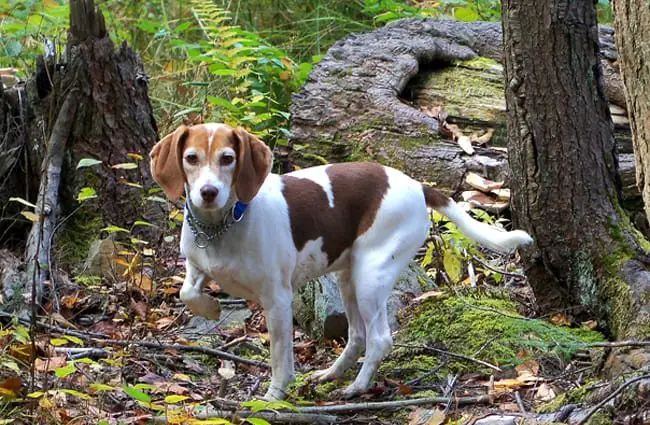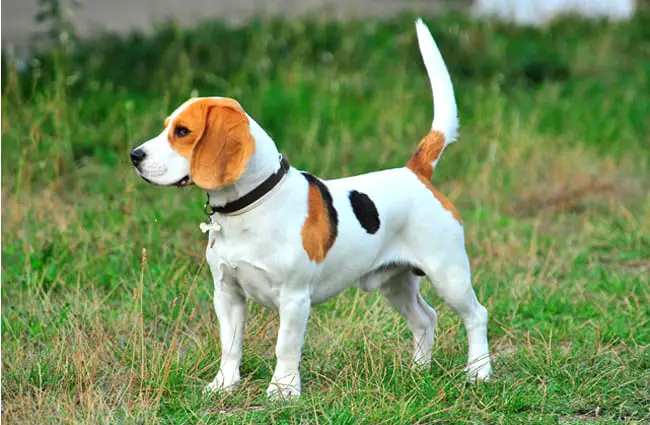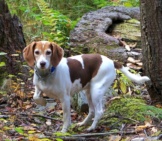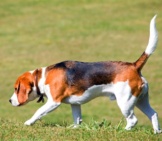The Beagle is an affectionate and easygoing dog that is the perfect companion for big families and new dog owners alike. Originally bred to live in packs as hunting dogs, Beagles do well in active homes where someone is always around.
Known for their soft floppy ears, big brown eyes, and loving nature it is no surprise that the Beagle has long been one of the most popular hound dogs around the world. Gentle and outgoing, these adorable dogs make a great addition to any family. Read on to learn more about the Beagle.
Description of the Beagle
The Beagle was originally bred as a scent hound and their noses are still used by many hunters today. Clever and energetic, this breed needs lots of activity to stay happy and healthy.
Their hound blood gives them a loyal and tenacious character. Sturdy and solid, Beagles are considered “big” for their small size. A square muzzle and broad nose are defining characteristics for this breed, along with their long hound ears and adorable pleading expressions.
The Beagle came into existence in the 11th century, when the Talbot Hound and Greyhound were bred together to create a dog with both speed and a strong nose. These are still favorable characteristics in Beagles today, and make them excellent companions for those with an active lifestyle.
The Beagle has a shorter coat that requires relatively low maintenance. They come in a variety of colors, from the classic tricolor of black, red, and white, to lemon.
Life Expectancy and Size
The Beagle can have some serious health problems that can drastically shorten his lifespan. The average lifespan is between 12 and 15 years, but hereditary problems like epilepsy can shorten this. That said, with proper care many of the breed’s health problems can be controlled, and they can live well into their teens.
While it can help to work with a reputable breeder who is committed to breeding healthy dogs, it is still not a guarantee of having a dog without health issues.
There are two varieties of Beagles, those that stand 13 inches tall, and those that stand 13-15 inches. Despite this relatively small size for both types, the breed is well built, athletic, and much sturdier than its small size might indicate. The smaller variety should weigh under 20 pounds, while the taller should be between 20-30 pounds.
Protective Ability
This breed is known for their mild nature and love of human company, and they often bark when they’re lonely. While the Beagle can make a great watchdog and will often let you know when a stranger is near, their affectionate nature does not make them a good guard dog. Choose the Beagle for his loving and loyal personality, not his ability to offer protection.
Training
Having been bred to be independent thinkers, the Beagle will require some extra time and patience with training. They do best with rewards-based training. This should involve treats, rather than simply relying on praise. Your dog needs a paycheck, too!
While using food rewards is an excellent way to train your Beagle, be sure to feed in moderation. This breed is notorious for becoming overweight easily, which can exacerbate health issues and cause serious stress on your four-legged friend! Reduce the size of your dog’s meals when you’re training with treats regularly.
The Beagle is bred to chase anything that moves, so it is very important they learn the basic commands of sit, stay, and come to keep them out of trouble. By associating these commands with positive reinforcement (treats), your dog is much more likely to listen. Patience and consistent praise for good behavior will help speed along the training process. Beagles have a short attention span, so keeping your training sessions to around 10 minutes will make things more efficient and effective.
As hunting dogs, you may find your Beagle taking you for a walk instead of the other way around. Whenever you find your dog pulling too hard, call their name and reward them with their favorite treat and soon they will realize that staying next to you is a much better way to spend their walk than chasing after invisible prey.
Energy Level
The Beagle needs daily exercise to stay happy and healthy. This will not only help keep them from being overweight, but it will also keep them from getting into trouble out of boredom or excess energy.
This breed can do well in most environments, from New York apartments to big country ranches, as long as they get daily exercise. While they love and need to run around, they are also very cuddly dogs and take frequent naps throughout the day. The most important requirement for the Beagle is adequate family time. These dogs love their humans and do not like being left alone.
What Living with a Beagle is Like
This is an all-around nice dog that loves spending time with kids, and is generally friendly with other pets. These dogs are very sturdy for their smaller size and can take just about anything in stride. In more sedentary families, they will enjoy lounging in the sun and snuggling on the couch. However, they are great outdoor companions and love to be active with their humans.
Unfortunately, these sweet dogs can have some serious health concerns, which may either shorten their lives, or be costly to manage.
Care of the Beagle
Adaptability is the Beagle’s middle name. They can live in many households as long as one condition is met: adequate social interaction with the family.
Environmental Needs
These dogs do not have many specific environmental needs. They are hardy and athletic, able to flourish in many climates. Their shorter coats don’t provide enough warmth in cold winter climates. In the extreme cold, they may need to wear a jacket or have their time outside limited. Like all dogs, they need adequate shade and water in hot temperatures.
Exercise Needs
This is one of the most important things besides social interaction that Beagles need. Provide at least 30 minutes of exercise for your Beagle everyday to keep your dog healthy and happy. An obese Beagle will have many more health problems and their personalities may be adversely affected.
Their hunting blood makes them great companions for the outdoor enthusiast, but no matter where they live as long as they get out everyday they will do well. Daily walks are usually enough to keep these dogs well-exercised. Ideally, these can be supplemented by time playing in the yard.
Beagles are avid chasers. It is important to keep them in a fenced yard or on leash, or they make take off to follow their nose or the nearest squirrel.
Shedding and Grooming
The Beagle’s short coat requires relatively little maintenance. They are light shedders and brushing them every few days is a good way to keep their hair on the brush and off of your couch. This breed does shed its winter coat in the spring so being more proactive with grooming that time of year will keep flying hairs to a minimum.
Baths only need to occur occasionally. Too many can even irritate this breed’s sensitive skin.
It is important to check the Beagle’s ears for infection. Many dogs with floppy ears are prone to this problem, and it is one of the biggest health concerns for the breed.
Ideal Home Environment
These dogs are popular with families. Their sweet temperament and adaptive nature mean that they can flourish with a variety of people. They may enjoy playing with kids or keeping senior citizens company.
This breed is not a good choice for those that want a guard dog. However, for most other families that want a pup that gets along with everyone in sight, the Beagle is a good choice.
It is important to acknowledge that this breed has potential health issues, which are not cheap to deal with.
Health Concerns
One of the biggest concerns with Beagles is epilepsy. These seizures are often hereditary and can require daily medication if it becomes an issue. It may be an expensive problem to deal with and may also cut their lives short.
Other issues include dwarfism, ear infections, and allergies. Eye infections are also a very common problem in this breed. Some of these disorders can be screened for. That said, having a Beagle without at least one of these health problems at some point in its life would be very rare.
Behavior Problems
Bred as pack dogs, this breed can have serious separation anxiety. If they become lonely, they will likely begin to bark or whine, and maybe begin destructive behaviors like digging to keep busy. They should not be left home alone for extended periods of time.
Additionally, even a happy Beagle can be loud. The baying bark of a hound is something to keep in mind if you share walls with neighbors. While adequate mental enrichment may reduce barking, it’s also in this dog’s nature to bay and bark. Look elsewhere if you need a quiet companion.
Their other big problem is chasing. Starting rewards-based training early can help them to listen more effectively while off leash. However, many Beagles still need to be on leash most of the time or remain in fenced yards.
Some of these dogs may become timid or aggressive if they are not properly socialized, so start your puppy off on the right foot by bringing him to puppy classes.


























![Red Angus Closeup of a beautiful Red Angus cowPhoto by: U.S. Department of Agriculture [pubic domain]https://creativecommons.org/licenses/by/2.0/](https://animals.net/wp-content/uploads/2020/03/Red-Angus-4-100x75.jpg)

